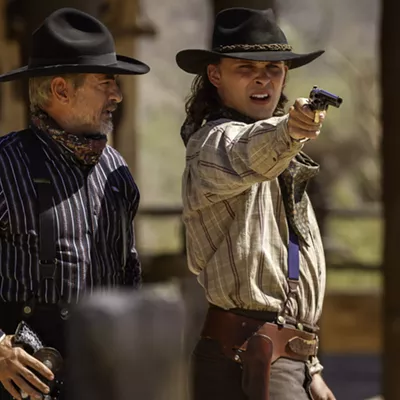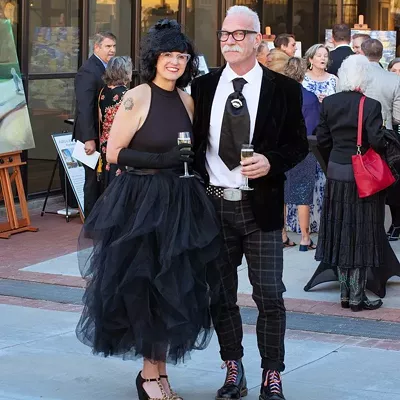The Venus of Willendorf, as any art history major can tell you, is one of the oldest representations of a naked woman.
Now renamed the Woman of Willdendorf, the carved stone figure, found in 1908 in Austria, may be 30,000 years old. This exuberant early nude, just 4 ½ inches high, positively revels in women's sexuality. Her breasts are pendulous, her belly is swollen and her vagina—rendered as a slit in the stone—is on voluptuous display.
Emma Kohlmann, a Massachusetts artist in her mid-20s, works in the Willendorf aesthetic, whether deliberately or not. In Gardens of the Pure, an exhibition of erotica by three women artists at MOCA-Tucson, she has filled a whole room with watercolors of nude women who have the same swelling curves, thick bodies, massive legs—and prominent vulvas—as the Willendorf does.
But Kohlmann's women are not alone. The artist brings naked men into her art party, along with figures of nebulous sexual identity. And where the Willendorf is static, these lively humans—as small as the actual Willendorf—joyfully leap into every sexual activity imaginable.
Colored in jolly yellows, or reds, or blues, or gray (one main color to each of the gallery's four walls), they delight in old-fashioned copulation every which way, from forwards to backwards to doggy-style. They taste the pleasures of oral sex, they masturbate side by side, and sometimes they simply content themselves with sexual display.
A smiling man in gray lies on his back, his penis curving aloft. A reclining woman likewise opens her legs to reveal the triangle of her pudendum. And in one sweet picture, two heads of indeterminate gender are locked in an affectionate kiss.
Kohlmann allows her colored inks and pungent watercolors to pool in rich washes of deep color and the figures are loose and animated. The cheeriness of these Matisse-colored works makes them "disarming and charming," as curator Jocko Weyland notes in his gallery text. And as he says, the cavorters' joyous hi-jinks celebrate not only creation but the life force itself.
For all their prettiness, these pieces have a formal grandeur. There are 108 separate paintings, each on a small sheet of paper, about 9 by 9 inches square, and Kohlmann has arrayed them in rows on the gallery walls. Not to push the Rock Art metaphor too hard, but when you stand inside the room, the works start feeling like cave paintings, chronicling the endless chain of human life, from millennia to millennia. We see human beings a lot like us who do the same things we do –live, have sex, reproduce, and die.
Gardens of the Pure laudably overturns the infamous convention of the "male gaze," in which male artists get to make erotic images, particularly of the female body, but women don't. The three women in this show, each given an entire room for her work, hail from three different generations—85-year-old Alice Mackler, born in 1931; 56-year-old Kitty Brophy, born in 1960; and Kohlmann, born in 1989.
But they all tackle the charged subject of the nude clear-eyed and without apology. Like Kohlmann, neither Brophy nor Mackler shies away from depicting sex.
Mackler's bodies are even more free-form than Kohlmann's. In 25 loosely rendered ink and gouache drawings on paper, Mackler, a New Yorker, pictures blissed-out Dr. Seuss-like figures. They float between splashes of yellow and turquoise and green, their copulating bodies seeming to return to their earliest cell forms and to their primeval amniotic fluid.
Sometimes they morph into creatures composed of two bodies turned into one. One figure has a woman's body from her head to her hips, but below that she/he is all man: that is to say, instead of legs, the figure has a giant (but abstracted) penis and testicles. Another has three happy heads joined together, their shared body tapering down to the shape of a sperm. Shedding the anatomy of reality,
Brophy, a Tucson artist, went to art school in New York in the late '70s and early '80s, the punk heyday of the low-rent, pre-AIDS East Village. Her pen-and-ink drawings, filled with masks and spiked heels and black stockings, capture the naughty goings-on at Club 57 on St. Mark's Place, the coolest street in the neighborhood.
Her 1978 "Disco Girls" depicts a Cabaret-like cavalcade of bare-breasted women with whips and masked naked men bound hand and foot. In "Deep Inside," from 1979, a nude woman who is tied up nuzzles another woman.
Brophy is still drawing nudes today, but some of them pay homage to the classic and the sedate. "Figure," from 2015, is a lovely contour pen-and-ink of a seated woman's back; it charts the lines of her body, from shoulder to buttocks. She also makes decorous drawings of penises, choreographing them into pinwheel patterns (in "Pricks," 2012) and arranging them head to head ("Parts Body Parts," 2015).
She still tackles boundary-breaking sex and fantasy, though. In "Story of My Life," 2015, a sexy cartoon lady takes a big lizard (or dinosaur?) out for a walk. Whatever the creature is, he's sporting a huge erection.
"This Doesn't Mean I Want You," a dramatic female nude with legs aloft, zeroes in on ravenous desire. And it's another vivid echo of the Willendorf: the woman in the picture displays her vulva front and center for all to see.











